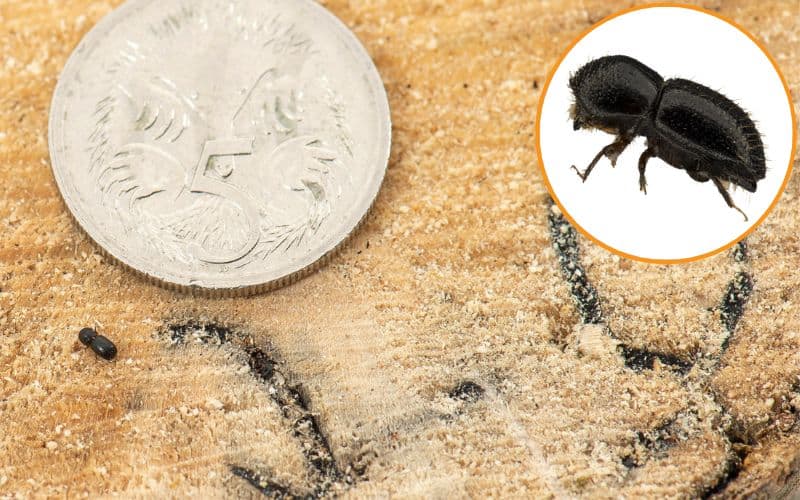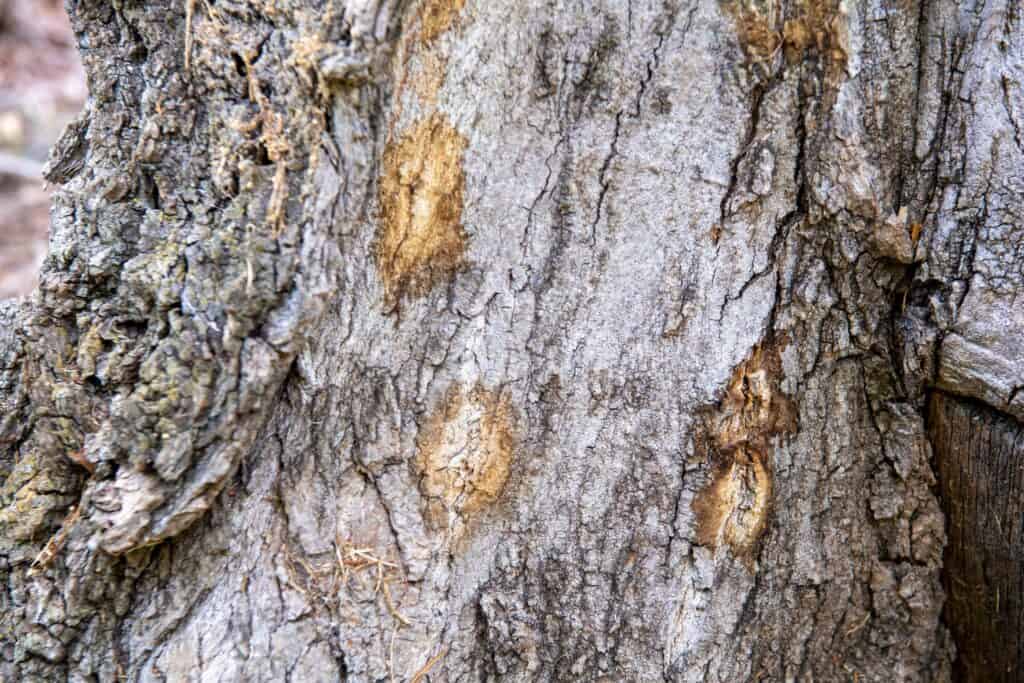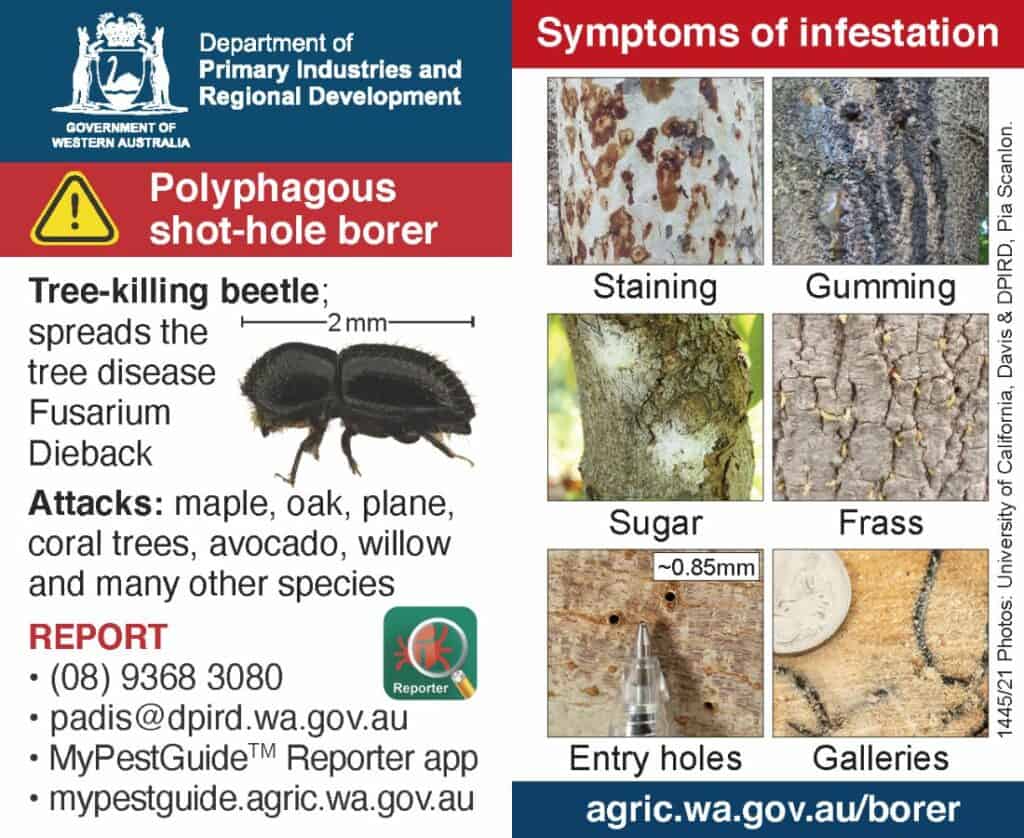In August 2021, a member of the public noticed some troubling symptoms on their maple tree in East Fremantle, WA, reporting signs of tree dieback and dead branches.
Follow-up inspections by state government officials confirmed the symptoms were caused by insects called polyphagus shot-hole borers.
The perfect invader
These tiny beetles are less than 2mm long and native to Southeast Asia. Their proper name is quite a mouthful, so we like to refer to them as “bullet beetles”.
Their distinctive impacts are the tiny tunnels they bore into trees to lay eggs in, leaving the tree looking like it is covered in bullet holes no bigger than the tip of a ballpoint pen.

Acting as a fungus farmer, the beetles carry around fungal spores in a special pouch in their mouthpart that they sow inside their tunnels. These spores then grow to become food for their young. One of the fungal species carried by the beetle causes wilting, die-back and eventually death in host trees.
They probably entered Australia via untreated wooden products or shipping materials, and have since been hitching rides around Perth and Fremantle on untreated garden waste and firewood. The WA Government’s outbreak webpage has now documented 139 confirmed infested premises across the regions as of June this year.
The big question mark now is just how big of an impact these borers could have on Australia’s environment. We already know they can infect hundreds of different tree species globally, including many regulars found in Australian gardens and farms. But there is also evidence they can infect many of our native trees like paperbarks, eucalypts and native figs, and woody plants like acacias.
They are also considered perfect invaders thanks to the ability of female bullet beetles to establish brand new colonies without mating. The fungus she carries guarantees food supply for her offspring.
Billions in damage
A quick check of what bullet beetles have done to similar ecosystems in countries like South Africa should be all we need to hear to take their arrival into Australia seriously.
Polyphagous shot-hole borers were introduced to South Africa in 2012, and have since spread to become the largest outbreak of the pest in any country.
A recent study estimates South Africa is now facing a bill of up to $18.45 billion over the next 10 years to cover the economic impacts caused by bullet beetles. Part of that cost will involve removing and safely disposing of around 65 million urban trees.

Similar stories have come out of Israel and the US after bullet beetles were detected in both countries in 2009 and 2012, respectively.
The most concerning part? While control activities are ongoing, there is no record of a successful eradication anywhere in the world, and there aren’t any established eradication methodologies.
Australia’s response in WA aims to break that record, and we’re optimistic it will be successful. Unlike other countries that have stared down the barrel of invading bullet beetles, this will be the first time a concerted early eradication effort of the pest has ever been attempted.
The current situation in Australia
The good news is that bullet beetles can only disperse a short distance on their own wing, sometimes using a little help from prevailing winds. Larger dispersal distances seen here in Australia and overseas can all be attributed to people moving infected wood. Stopping their spread is therefore a matter of stopping the unsafe movement of untreated wood from infected regions.
That’s why the WA Government has now implemented a quarantine area preventing the removal of wood above a certain size from 21 local government areas in and around Perth. A regularly updated map of the quarantine area and details of quarantine restrictions are currently available here.
The WA Government has sought a national response through the Consultative Committee on Emergency Plant Pests (CCEPP), which is putting in place a phased, three-year plan aiming to eradicate the pest. We commend the national response coordinated by the WA Government and its desire to pursue eradication of a pest that has the potential to be one of Australia’s most problematic emerging invasive species.
Unfortunately, the response was slower than it needed to be given the massive implications for Australia’s unique flora but, finally, there is now sufficient resolve to treat the issue seriously.
We will continue to closely monitor the situation to ensure the state government provides the support and resources necessary to give eradication plans every chance at succeeding.
Polyphagous shot-hole borers have an unknown potential to cause widespread damage to native Australian forest trees. If eradication is possible, we need to achieve it. We can’t let these bullet beetles loose on Australia’s trees.
The current situation in Australia
If you live in or near the current quarantine area, see the WA Government’s reporting advice below:

Residents who suspect they have borer damage to trees should make a report to the WA Department of Primary Industries & Regional Development (DPIRD) through the Pest and Disease Information Service on 9368 3080 or via the department’s MyPestGuide™ Reporter app (available on the Google Play Store and Apple iTunes Store), or email padis@dpird.wa.gov.au.

